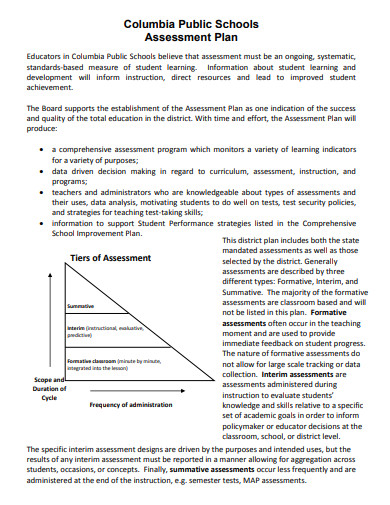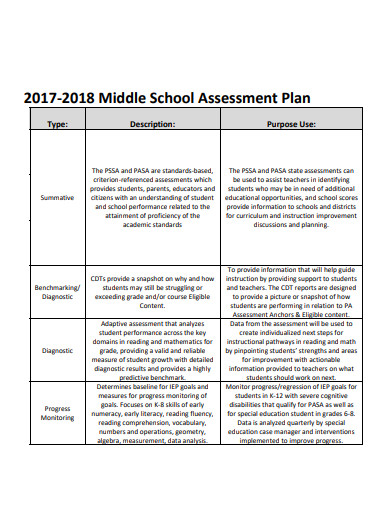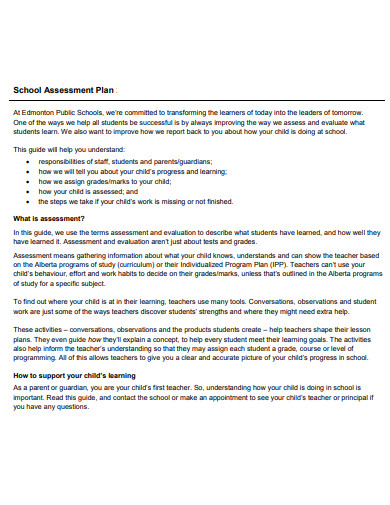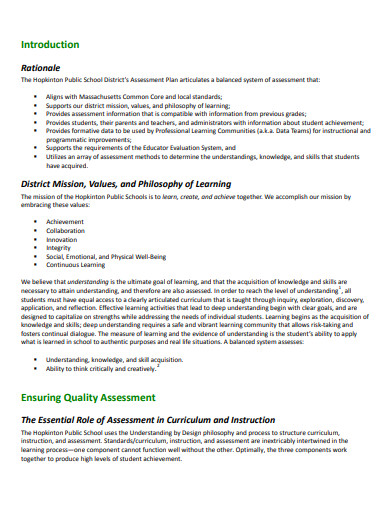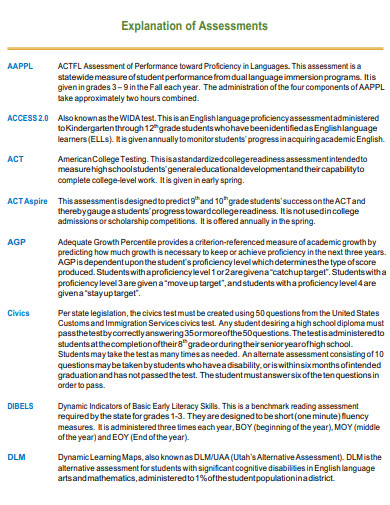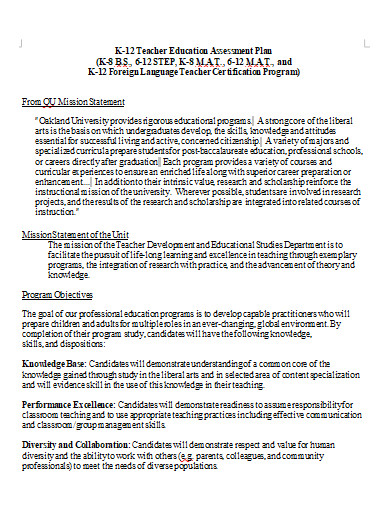An assessment strategy should be created before the project activities and tasks to guarantee that the project maintains focus on the desired learning outcomes. Because projects allow for more individual expression of learning, assessment procedures must be flexible enough to accept a wide range of student activities while remaining focused on desired outcomes. It lays out strategies and resources for defining explicit expectations and criteria for product and performance quality. It also specifies project checkpoints and strategies for informing the teacher and keeping students on track. Learners should be involved in goal-setting, assessing and controlling their learning progress, and self-reflection following the project, according to the plan.
The aim of the assessment process, and the major crux of the assessment cycle, is to enhance and improve educational practices, processes, and policies as a result of evidence-based decision-making and change implementation. It is critical to document the process and the decisions made as a result of it to be structured, transparent, and accountable. Assessment planning is a task that should be completed by a program or department at the start of their assessment cycle. As a result, the planning process should begin in late summer and an evaluation plan should be completed by the beginning of the autumn semester to enable enough time to put the plan into action.
10+ School Assessment Plan Samples
1. School Assessment Plan
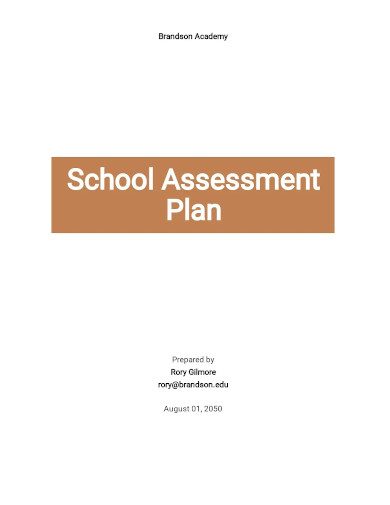
2. Public School Assessment Plan
3. Middle School Assessment Plan
4. School Comprehensive Assessment Plan
5. Pre-School Assessment Plan
6. Grade School Assessment Plan
7. Community School Assessment Plan
8. School of Education Assessment Plan
9. Sample Public School Assessment Plan
10. School Assessment Plan Example
11. Printable School Assessment Plan
Key Concepts in Developing School Assessment Plan
- Create a school-wide reading assessment plan and database to track students’ progress over time.
An outcomes-based assessment plan’s main goal is to assist educators in making informed decisions about how to improve student learning. This aim can be achieved with the support of a structured and effective assessment system that focuses on measuring the essential reading abilities at each grade level. Assessments to be administered, time frames for administering each assessment, target students, and, as a reminder, the aims of each assessment should all be included in the plan. - A school’s comprehensive reading strategy should include a variety of assessment methods.
Various sorts of assessments are used for various purposes. Within their schoolwide assessment plan, every school should have at least four different types of assessments. There are two types of assessments: (1) screening assessments and (2) diagnostic assessments/tools. (3) Formative evaluations, such as progress monitoring and in-program evaluations (4) Evaluations of the outcomes. - Data from assessments can be used for a variety of purposes. Assessment data can assist school personnel in identifying:- Students who are on grade level or above, who are at danger of reading failure, or who are at high risk of reading failure
– All students have educational needs.
– Students in groups who are having trouble fulfilling their goals/expectations
– Teachers who are faithfully implementing the comprehensive reading program and interventions vs. teachers who are not
– Teachers in need of help and teachers who can mentor others
– The expansion of a school’s comprehensive reading program as a whole
– Needs for professional development for school employees - Ascertain that the evaluations used by your school are both legitimate and dependable.
The amount to which a tool, in this example a reading assessment system, measures what it is designed to measure is referred to as validity. The consistency with which an assessment identifies students from one test administration to the next is referred to as reliability. When a test is conducted under diverse conditions, at different times, and/or using different variations of the exam, the findings are considered reliable.
FAQs
What does an assessment plan outline?
– Student learning outcomes or department goals to be assessed during that academic year
– Direct and indirect assessment methods used to demonstrate achievement of each outcome or goal
– Brief explanation of the assessment methods, including the data source(s)
– Indication of which outcome(s) or goal(s) is/are addressed by each method
– Intervals/timelines for data collection and review
– Individual(s) responsible for data collection/review
What are other additional components you can find in a school assessment plan?
An assessment plan may also include the department or program’s mission, curriculum maps that link outcomes with courses, and a thorough implementation plan for each technique or outcome/goal. There is frequently an assessment plan template that is used by all departments within a college or division to ensure that all components of the planning process are handled and submitted to leadership for review in a consistent style.
How do you structure a school assessment plan?
It is crucial to understand the fundamental aim of the test being administered, as well as how trustworthy and valid the assessment results are when using them to make decisions, before selecting or administering an assessment for a school or district. Certain redundancy will become apparent if the goal of each type of assessment is carefully considered while an overall assessment strategy is being developed, and the school or district may be able to reduce the number of assessments used. When a school, district, or state has a unified assessment plan in place, including a professional development component, educators may critically review why they are using specific exams and be more purposeful in their data use.
After an assessment strategy has been completed and data has been collected, it’s time to think about the various needs and other alternatives for reporting, or more broadly, sharing assessment data. Leadership frequently requires departments and programs to provide an annual report that includes an assessment section.
Related Posts
FREE 9+ 30-Day Marketing Plan Samples in PDF | MS Word | Apple Pages | Google Docs
FREE 3+ Sales Team Action Plan Samples in PDF | MS Word | Apple Pages | Google Docs
Marketing Plan For Small Business Samples
FREE 7+ Fashion Business Plan Samples in PDF
FREE 10+ Sprint Planning Samples In MS Word | Google Docs | PDF
FREE 10+ Wedding Planning Samples in MS Word | Apple Pages | Powerpoint | PDF
FREE 9+ Monthly Study Planner Samples in PSD | Illustrator | InDesign | PDF
FREE 9+ Sample Curriculum Planning Templates in PDF | MS Word
FREE 10+ Teacher Development Plan Samples in MS Word | Google Docs | Apple Pages | PDF
FREE 10+ Basketball Practice Plan Samples in PDF
FREE 12+ School Business Plan Samples in PDF | MS Word | Apple Pages | Google Docs
FREE 7+ Client Strategic Plan Samples in PDF | MS Word
FREE 11+ Trucking Business Plan Templates in PDF | MS Word | Google Docs | Pages
FREE 7+ Small Hotel Business Plan Samples PDF | MS Word | Apple Pages | Google Docs
FREE 14+ Bakery Business Plans in MS Word | PDF | Google Docs | Pages

